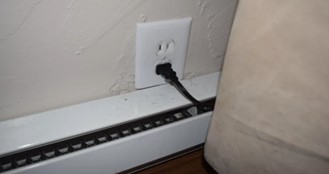There are various types of electric heating systems. They all use electricity to transfer heat in the following three ways:
- forced air;
- convection; and
- radiation.
Here, we are concerned with the use of electric baseboard heaters as a heating source in commercial buildings.
Convection is known by most people by the phrase “heat rises.” Convection is the transfer of heat by warming the air next to a hot surface, and then moving that warm air.
It’s the transfer of heat by the motion of the heated matter itself. The air moves from one place to another, carrying heat along with it. Since warm air is lighter than the cool air around it, the warm air (or heat) rises.
Radiation is the transfer of heat energy by electromagnetic wave motion. Heat is transferred in direct rays. It travels in a straight line from the source to the body. The closer you are to a hot object, the warmer you feel. The intensity of the heat radiated from the object decreases as the distance from the object increases.
Installation and Design Considerations
Electric baseboard heaters are zonal heaters controlled by thermostats located within each room. Baseboard heaters contain electric heating elements encased in metal pipes. The pipes, surrounded by aluminum fins to aid heat transfer, run the length of the baseboard heater’s housing or cabinet. As air within the heater is warmed, it rises into the room, and cooler air is drawn into the bottom of the heater. Some heat is also radiated from the pipe, fins, and housing.
Any impedance or blockage will diminish the heating potential of electric baseboard heaters. This could be through a simple obstruction like furniture or doors, or window treatments, such as blinds or curtains.
This type of heat source is common in multi-family buildings, and residential buildings converted into commercial buildings. It is also common in areas where supplemental heat is needed, such as in vestibules, and under windows where drafts occur in cold climates. Baseboard heaters are seldom located in the far interior of a building, but instead along the building’s inside perimeter, where the greatest heat loss occurs.
NOTE: Baseboard heaters should sit at least 3/4-inch above the floor or carpet. This is to allow the cooler air on the floor to flow under and through the radiator fins so it can be heated. The heater should also fit snugly against the wall to prevent the warm air from passing behind it and streaking the wall with dust particles. If it’s in the path of a swinging door, there should be at least 18 inches of clearance between the opened door and the baseboard unit.
In most cases, heating is measured in British Thermal Units (BTUs). This is the measurement of heat necessary to bring 1 pound of water up 1 degree in temperature at sea level. When looking at electric baseboard heating, the measurement of energy or heat is calculated in watts. The amount of watts necessary to heat a room is about 5 to 8 watts per square foot of space. This can vary, depending on insulation, the height of the ceiling, the presence and location of windows, and air infiltration.
Electric baseboard heating can be purchased only in whole-foot increments, and can be 110-volt or 240-volt systems. Most baseboard units are about 250 watts per linear foot. If a room is 10×10 feet (or 100 square feet), it would require 500 to 800 watts, or 3 feet of baseboard heating. This calculation is beyond the scope of the ComSOP, but having a working knowledge of what is necessary to adequately heat a space is very important for inspectors. Especially when inspecting multi-family buildings, it is important to identify if there is an adequate heat source in every habitable room.
Common Defects of Electric Baseboard Heaters
Electric baseboard units produce considerable heat and can likely, over time, melt an object that comes in contact with it. This is one of the reasons that there should never be an electrical receptacle installed above any electric baseboard heating unit. The cord can melt and cause an electrical shock or fire. It is also important for the inspector to look for any other obstructions to ensure that the units are operating efficiently and safely.

These units can be easily damaged, including by being hit by furniture or accidentally kicked, which can dent the housing and/or the internal fins, or even knocked off the wall altogether, which may additionally pose a fire hazard. These units may not be maintained well and might be dirty. Simply looking between the various louvers and fins can be enough to identify these issues. Connections to an electric baseboard heater should be solid, in good condition, and not exposed. Inspectors should alert their clients of any such defects. For guidance during an inspection, use the Inspection Checklist for Electric Baseboard Heating.
Takeaway for Commercial Property Inspectors
Electric baseboard heaters are a common source of zonal heating in multi-family properties. These units are also used to counteract drafts and other forms of heat loss from windows and vestibules. Commercial property inspectors should visually assess electric baseboard heaters and verify their operation using the corresponding thermostat. For heating efficiency and safety reasons, it is important for these units to be free of obstructions, especially electrical outlets, cords, and other potential fire hazards. Inspectors should also take note of the unit’s general physical condition, and check that it is securely attached to the wall.
Article Written By: Rob Claus, CMI®
Additional Resources for Commercial Property Inspectors:


